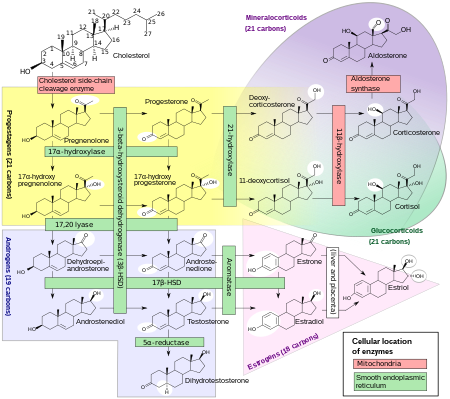11β-Hydroxysteroid dehydrogenase enzymes catalyze the conversion of inert 11 keto-products (cortisone) to active cortisol, or vice versa, thus regulating the access of glucocorticoids to the steroid receptors.

11β-Hydroxysteroid dehydrogenase type 1, also known as cortisone reductase, is an NADPH-dependent enzyme highly expressed in key metabolic tissues including liver, adipose tissue, and the central nervous system. In these tissues, HSD11B1 reduces cortisone to the active hormone cortisol that activates glucocorticoid receptors. It belongs to the family of short-chain dehydrogenases. It is encoded by the HSD11B1 gene.
3β-Hydroxysteroid dehydrogenase/Δ5-4 isomerase (3β-HSD) is an enzyme that catalyzes the biosynthesis of the steroid progesterone from pregnenolone, 17α-hydroxyprogesterone from 17α-hydroxypregnenolone, and androstenedione from dehydroepiandrosterone (DHEA) in the adrenal gland. It is the only enzyme in the adrenal pathway of corticosteroid synthesis that is not a member of the cytochrome P450 family. It is also present in other steroid-producing tissues, including the ovary, testis and placenta. In humans, there are two 3β-HSD isozymes encoded by the HSD3B1 and HSD3B2 genes.
17β-Hydroxysteroid dehydrogenases, also 17-ketosteroid reductases (17-KSR), are a group of alcohol oxidoreductases which catalyze the reduction of 17-ketosteroids and the dehydrogenation of 17β-hydroxysteroids in steroidogenesis and steroid metabolism. This includes interconversion of DHEA and androstenediol, androstenedione and testosterone, and estrone and estradiol.
In enzymology, a 12alpha-hydroxysteroid dehydrogenase (EC 1.1.1.176) is an enzyme that catalyzes the chemical reaction
In enzymology, a 16alpha-hydroxysteroid dehydrogenase (EC 1.1.1.147) is an enzyme that catalyzes the chemical reaction
In enzymology, a 20-α-hydroxysteroid dehydrogenase (EC 1.1.1.149) is an enzyme that catalyzes the chemical reaction
In enzymology, a 21-hydroxysteroid dehydrogenase (NAD+) (EC 1.1.1.150) is an enzyme that catalyzes the chemical reaction
In enzymology, a 21-hydroxysteroid dehydrogenase (NADP+) (EC 1.1.1.151) is an enzyme that catalyzes the chemical reaction
In enzymology, a 3alpha(17beta)-hydroxysteroid dehydrogenase (NAD+) (EC 1.1.1.239) is an enzyme that catalyzes the chemical reaction:
In enzymology, a 3alpha-hydroxysteroid dehydrogenase (A-specific) (EC 1.1.1.213) is an enzyme that catalyzes the chemical reaction
In enzymology, a 3alpha-hydroxysteroid dehydrogenase (B-specific) (EC 1.1.1.50) is an enzyme that catalyzes the chemical reaction

In enzymology, a 3alpha(or 20beta)-hydroxysteroid dehydrogenase (EC 1.1.1.53) is an enzyme that catalyzes the chemical reaction
In enzymology, a 3-β(or 20-α)-hydroxysteroid dehydrogenase (EC 1.1.1.210) is an enzyme that catalyzes the chemical reaction
In enzymology, a 7alpha-hydroxysteroid dehydrogenase (EC 1.1.1.159) is an enzyme that catalyzes the chemical reaction
In enzymology, a 7beta-hydroxysteroid dehydrogenase (NADP+) (EC 1.1.1.201) is an enzyme that catalyzes the chemical reaction

Aldo-keto reductase family 1 member C3 (AKR1C3), also known as 17β-hydroxysteroid dehydrogenase type 5 is a key steroidogenic enzyme that in humans is encoded by the AKR1C3 gene.

Aldo-keto reductase family 1 member C1 also known as 20α-hydroxysteroid dehydrogenase, 3α-hydroxysteroid dehydrogenase, and dihydrodiol dehydrogenase 1/2 is an enzyme that in humans is encoded by the AKR1C1 gene.

3α-Hydroxysteroid dehydrogenase is an enzyme that in humans is encoded by the AKR1C4 gene. It is known to be necessary for the synthesis of the endogenous neurosteroids allopregnanolone, THDOC, and 3α-androstanediol. It is also known to catalyze the reversible conversion of 3α-androstanediol (5α-androstane-3α,17β-diol) to dihydrotestosterone and vice versa.

Aldo-keto reductase family 1 member C2, also known as bile acid binding protein, 3α-hydroxysteroid dehydrogenase type 3, and dihydrodiol dehydrogenase type 2, is an enzyme that in humans is encoded by the AKR1C2 gene.
This page is based on this
Wikipedia article Text is available under the
CC BY-SA 4.0 license; additional terms may apply.
Images, videos and audio are available under their respective licenses.







